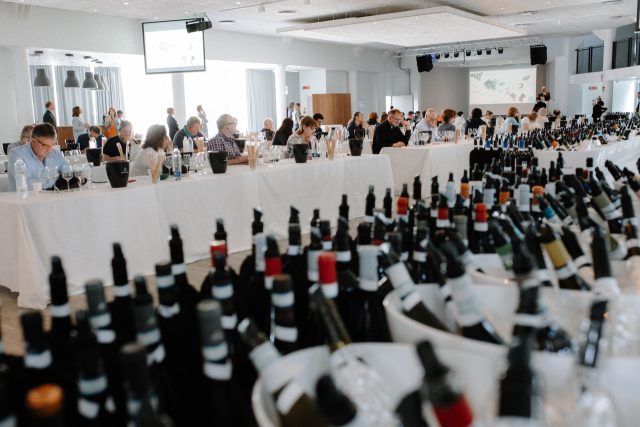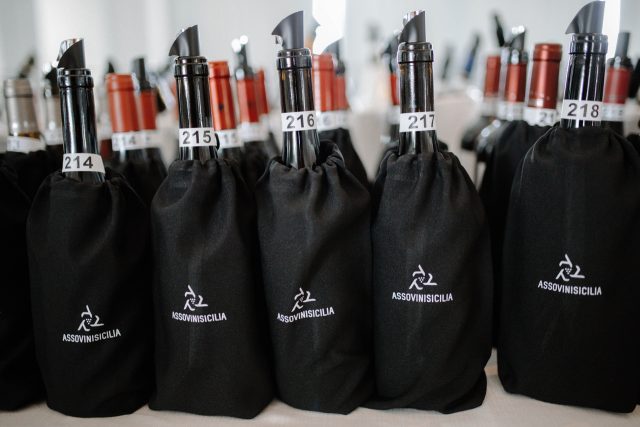Sicilia En Primeur 2024: brightness and resilience
Filippo Bartolotta reports on how this year’s Sicilia En Primeur event in Cefalù, on the Mediterranean island’s northern coast, showcased how Sicilian producers are adapting to a rapidly changing wine world.

“Believing in wine as a cultural product, with extraordinary and unique potential, and not just as a product has been Sicily’s great revolution,” said Mariangela Cambria, president of Assovini Sicilia.
“Working as a team as allowed us to push Sicilian viticolture towards high quality, hence contributing to its success”, echoed Antonio Rallo, a former president of Assovini Sicilia and current president of Consorzio di Tutela DOC Sicilia.
The enthusiasm among producers is almost overwhelming, the atmosphere more effervescent than in many other regions. The present and future look bright for Sicily, thanks to a perfect match between the rising popularity of the region as a tourist destination and steady improvements in the quality of the wines.
Everybody is aware of the fact that 2024 may be one of the most difficult years for the global wine industry in memory, and yet Sicily seems to have more than a few cards up its sleeve.
First and foremost, it houses one of the largest quantities of organic vineyards in the world. According to a new study by Uva Sapiens, which was presented during the last edition of Sicilia En Primeur, only Castilla La Mancha and Occitaine in France have a higher proportion of organically farmed vineyards. But organic viticulture isn’t the only way that Sicilian wineries are trying to tackle the urge to go green: the SOStain association promotes sustainability on a broader scale – its members aim to achieve energy efficiency, safeguard fragile natural ecosystems, put commitment into corporate welfare, and they even adopted an ultra-light bottle.
The rediscovery of forgotten native varieties is another important trend. About half of the island’s 95 indigenous varieties have been at risk of extinction in recent decades, and with the Bi.vi.Si project, the Sicilia DOC consorzio is promoting the study, experimentation and replanting of the so-called relic cultivars.
Lucignola, Vitrarolo and Orisi are just some of the names you will hear more often in the future. Some of these “forgotten” varieties are starting to show up in big and small wineries.
At the moment we are talking about a few hundred bottles here and a few hundred bottles there, but the results are encouraging. From the few tastings I have carried out in recent years, the common trait is a zippy acidity, vibrant fruit and a savoury taste. Also, all of these varieties seem to produce low yields (which might be one of the reasons why they have been abandoned) and share a surprising heat-resistant quality, which could make them the best ally against climate change and for the dry-farming conditions which characterise most of the island.
The 2023 vintage in a nutshell
The excitement among Sicilian producers is palpable in spite of 2023 having been the umpteenth challenging vintage in the last decade and the 2024 season starting with an alarming shortage of water due to below-average rainfalls during winter. Even though the situation has slightly improved thanks to a few showers in recent weeks, the regional government has already proclaimed a state of alert.
After the extreme drought conditions that marked 2022, heavy rainfall during springtime was the main problem producers had to face in the 2023 vintage. This led to severe peronospora outbreaks and caused a 31% decrease in total volumes.
But Sicily is large and heterogeneous, and the differences between one area and another were even more remarkable in this vintage than in the previous ones: for example, southeastern Sicily recorded only 33 rainy days during the growing season, compared to 67 in Etna. This variation is greater than that between the key winegrowing areas of Tuscany and Langhe in Piedmont.
A hot spell at the end of July saved the harvest by boosting the ripening process. Temperatures in August were just above average (+1.2°C), while September and October were the hottest ever recorded (although diurnal swings ensured the retention of good acidity, especially in cooler or higher altitude areas).
The white wines from the 2023 vintage that have already hit the market are especially expressive and approachable, with ripe acidity, lifted aromatics, and above-average concentration, a consequence of the intense sunshine in September and October and lower yields than usual.
Red grapes have suffered the most, with Nerello Mascalese on Etna recording declines in yield in excess of 90%. Many wineries on the volcano simply decided not to produce any red wine from this vintage.
Nero d’Avola is equally susceptible to rot – and less so to drought – and in wetter areas it also registered significant drops in production. Territories such as Vittoria and Noto, in the southeast of the island, make an exception because of their drier and warmer climate.
Latest vintages aside, the new releases from Sicily speak of an overall shift towards a lighter and brighter style. Remember the big, bold and creamy blockbusters from the late 90s and early 2000s? Well, there is almost no trace of them left. The rise to success of the perfumed and medium-bodied wines of Etna has spearheaded a change in the perception of Sicilian wine, and has promoted a stylistic shift in most winegrowing areas across the region.
Even Nero d’Avola is totally different from the past: plantings in cooler sites and at higher altitudes (up to 900 meters above sea level), lighter extraction, and a more subtle use of oak are the means through which iconic and up-and-coming wines manage to avoid heaviness and rusticity, emphasising instead the variety’s signature high acidity and charming fruitiness.

Partner Content
Trendsetting Sicilian wines – the whites
Castellucci Miano, Shiará Doc Contea di Sclafani 2022
A monovarietal Catarratto from one of the highest vineyards in Western Sicily, touching 1,000 masl. It displays herbal nuances, yellow flowers, gunflint, wild fennel, and lime. An iron fist in a velvet glove, with sharp acidity supported by soothing orchard fruits and candied lemon, with a mouthwatering mineral finish.
Tenuta di Fessina, A Puddara Etna Bianco 2022
An iconic Etna Bianco from 100% Carricante grapes growing on the southwest of Etna, with the vineyard peaking at 900 masl. Iodine, nectarine, sweet almond, white peach, and just a whiff of cinnamon spice from ageing in large oak. A rock ‘n’ roll wine focusing on laser-like tension tension and refreshing crispness right now, almost a bit Chablis-like, with a long citrusy finish. So delicious but you can keep it in your cellar and it will last for several years.
Tasca d’ Almerita, Grillo di Mozia Tenuta Whitaker 2023
From the highest reaches of the island to the salt marshes of Marsala, where the Tasca family produces an iconic Grillo. You can smell the marine breeze right away, with a touch of anchovies and some attractive zesty herbs followed by lemon peel and white almond. Quite smooth on the entry and then increasingly savoury, with a tangy herbal touch on the background, it’s impossible not to daydream about sipping this while watching the sunset on a lonely beach on the western coast of Sicily.
Tenute Lombardo, Grillo d’Altura 2023
When planted at 650 masl in the area of Caltanissetta in Central Sicily, Grillo develops a completely different personality. Here you get more lifted floral aromas of jasmine and broom mixed with grapefruit and white melon. Slimmer than the Mozia, it could be mistaken for something produced in northern Italy because of its ultra crisp, almost alpine acidity and elegant floral and peppery finish.
Trendsetting Sicilian wines – the reds
Casa Grazia, Laetitya Frappato 2023
‘Laetitya’ derives from the Latin word ‘laetitia’, which means happiness. It’s the perfect word to describe Frappato, a native variety of Southeastern Sicily which gives cheerful wines such as this Beaujolais-like, unoaked example, offering a saline note of anchovy hinting at the proximity of the vineyards to the coast with some reductive spicy herbs and crunchy red fruits in the background. Light, easygoing, with palate-cleansing acidity and a fruit-forward and slightly tangy finish, it makes you crave pasta all Norma.
Feudo Montoni, Vrucara Prephilloxera, Nero d’Avola 2019
A perfect example of an uncompromising Nero d’Avola that is both old school and new wave, focusing on both transparency and purity of fruit and structure of this pre-phylloxera plants. Sweet and ripe sour cherries, eucalyptus and mountain flowers, liquorice and some dry rose petals. A lovely acidity lifts the succulent red and black fruit and the over 3 years of cement aging plus a brief oak barrel passage only adds a deeper textural volume, a touch of spiciness and a really lingering juicy finish with an earthy and leathery touch.
Cantine Fina, Vitrarolo 2023
The first commercial wine made with this historic grape. Dark-coloured, the nose is juicy and bright with some peppery spiciness alongside crunchy black fruits and juniper berries. Succulent and fruit-forward with good acidity and mild tannins, it’s a perfect wine for hearty pasta and charcuterie.
Pietradolce, Etna Rosso Archineri 2020
100 to 120 year-old ungrafted vines make for a textbook expression of Etna with a light ruby colour and supple aromas of crunchy red fruits, incense, volcanic ash, and dark spice. Pinot-ish strawberries and wild berries follow up on the palate, interlaced with silky tannins and mouthwatering minerality, and a peculiar nuance of gunflint and ash that lingers on the long finish.
Arianna Occhipinti, Cerasuolo di Vittoria Grotte Alte 2019
A magnificent wine from the superstar grower who shined a light on the Vittoria appellation in southeastern Sicily, where limestone-rich white soils allow the Nero d’Avola and Frappato grapes to defy the heat and retain incredibly high acidity and lovely fruit purity. A slightly reductive, iron note leads to wet earth, tapenade, anchovy paste, and the juiciest strawberries and raspberries. Super lifted, airy and ethereal, with a refreshing herbal touch deriving from a bit of whole-bunch fermentation on Frappato, and loads of sweet red fruits and florals on the long finish. The epitome of the rediscovery of lightness in Sicilian wine!
Related news
Bottega celebrates Unesco recognition of Italian cuisine




